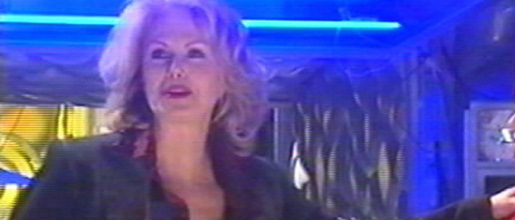Christian Cawley's Blog, page 126
March 12, 2015
NuWho 10th Anniversary: What Is Your Favourite Series 2 Story?
Philip Bates is a writer at Kasterborous Doctor Who News and Reviews - All the latest Doctor Who news and reviews with our weekly podKast, features and interviews, and a long-running forum.
This year, Doctor Who has been back on our screen ten whole years. It feels like yesterday that the TARDIS materialised once more; suitably, it also feels like forever.
So join us as we celebrate a decade with the Ninth, Tenth, Eleventh, and Twelfth Doctors. Let’s find out which serials are our favourites, and shine a light on the underrated ones too. Watch us run.
And then vote on your favourites. At the end of the year, we’ll find out which serials showcase our beloved show at the height of its game.
The Doctor has a new face. Series 2. Rose Tyler carries on through time and space with a man who has regrown his hand, likes his teeth, and has really great hair. They’re off to New Earth; see an old friend; crash into a parallel world; fight a scribble monster; and come face-to-face with the Cult of Skaro. How long is she going to stay with him? Forever. Apparently…
Alex Skerratt: The Impossible Planet/ The Satan Pit
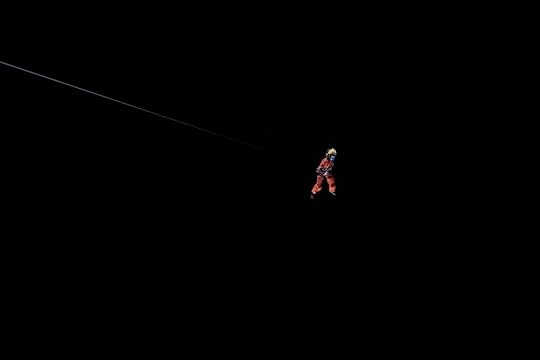 The Impossible Planet / The Satan Pit has to be one of the Series 2 highlights, in my ‘umble opinion. Although to call it a ‘highlight’ is slightly disingenuous, as it’s actually one the darkest stories of the season, if not the entire Who canon!
The Impossible Planet / The Satan Pit has to be one of the Series 2 highlights, in my ‘umble opinion. Although to call it a ‘highlight’ is slightly disingenuous, as it’s actually one the darkest stories of the season, if not the entire Who canon!
But I admire its bravery. I think it pushes the boundaries of horror to the limit, following in the footsteps of such flicks as Event Horizon and, dare I say it, The Exorcist. As a Christian, I also find it refreshing to watch the Doctor tackle some of those bigger questions, such as does God exist, does Satan exist, and did anything exist before the creation of the Universe? Plus, the story features the surreptitious and seductive tones of Gabriel Woolf, who delivers a truly terrifying performance as the voice of the Beast. Nine year-old me would have been sleeping with one eye open!
Becky Crockett: The Girl in the Fireplace
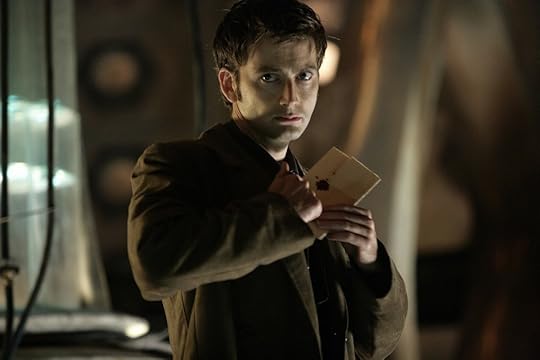
Favorite story? Same one a lot of people will mention – The Girl In The Fireplace. There’s just so much about it – the insane combination of a spaceship and the French royal court that completely makes sense, the creepy, very sci-fi idea of being able to fix a spaceship using human body parts, the time travel WITHOUT the use of the TARDIS, and that for a change, the Doctor is so overwhelmed by someone else instead of being the one that confounds people. He just can’t help but want to be with Reinette. And then there’s that kiss…
Scott Varnham: Army of Ghosts (but not Doomsday)
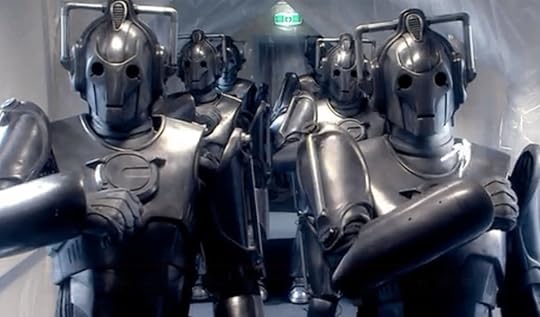
You know, Doomsday gets all the hype (coming top in lists of emotional moments and whatnot), but for me it’s Army Of Ghosts that’s the better story of the two on offer here. Ol’ Rusty turns what should’ve been a fairly dull build-up episode into the more interesting of the two (admit it, there are only two reasons to watch Doomsday: Stephen Hawking vs. the Speaking Clock, and That Bit On The Beach).
Army Of Ghosts gives the concept of hauntings the interest and exploration it deserves and sustains a well-plotted mystery, which really helps to make this episode one of the more interesting ones under Davies’ reign. (Although it’s not my favourite; that honour is reserved for Utopia…)
Jonathan Appleton: The Girl in the Fireplace
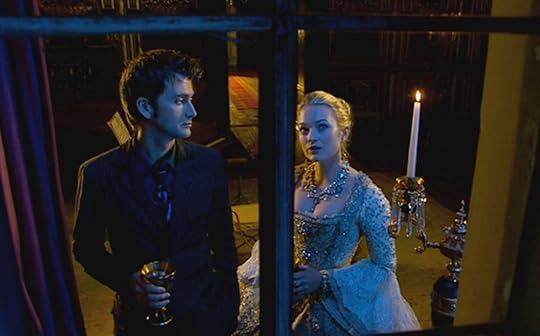
No doubt this choice makes me a sentimental old fool, but I find this beautifully told, elegant story endlessly re-watchable.
We didn’t really need reminding by this point that the revived Doctor Who was prepared to do stories that the old series would never have gone anywhere near, but this tale of the Doctor finding and then losing his one true love certainly provided confirmation. The scene where Rose visits Reinette to warn her just how much danger she’s in is one of my favourite scenes in pretty much any series of anything. Rose’s moment of realisation that, however strongly the Doctor may feel about her, it’ll never match the feelings he has for this remarkable woman (“He was right about you…”) is truly wonderful stuff, even if it was rather undermined by all that blubbing in Bad Wolf Bay later on.
James Lomond: The Impossible Planet/ The Satan Pit
This is perfect Doctor Who. There are no campy winks to the audience, no design mistakes, and no dialogue disasters. Just good characters, good drama, a good story and some of the best and most haunting music Murray Gold has written on Who.
The Ood, before the shades thrown on them by later capers and silliness, were perfectly introduced and used to optimum sinister effect.
So much worked brilliantly in this episode. An ancient underground civilisation, Rose and Ten awkwardly pondering a mortgage, the dwindling crew trapped on the brink of oblivion and the Doctor engaging in a real and believable existential conversation without treading on any religious egg shells. There were some wonderful performances here, notably from Clare Rushbrook and a gutsy, satisfying ending. The script, actors and direction manage to convey a real sense of loneliness and fear while never letting the story lose pace. Brilliant. Loved it. Love it. More like this, please!
Drew Boynton: School Reunion
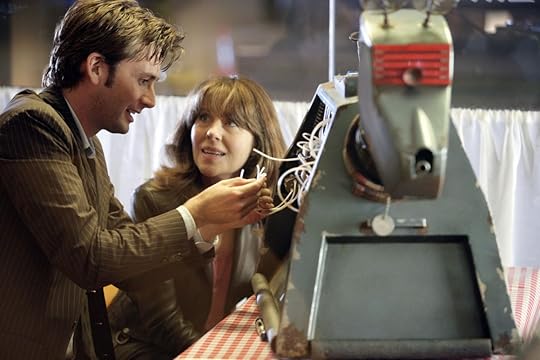
In a series full of entertaining winners like The Girl in the Fireplace and Tooth and Claw, not to mention the two-part emotional rollercoaster that is Army of Ghosts/Doomsday, I will take School Reunion every time. Every time.
From the introduction of Sarah Jane and K-9 to a new generation of Whovians, to the sneering Master-like villainy of guest star Anthony Head (loved him on Buffy and Merlin!), to the hilarious-yet-poignant realization by Mickey Smith that HE’S the modern day “tin dog,” to the heart-stopping scene in which Sarah Jane stumbles upon the TARDIS in a darkened school basement, to the tear-inducing finale (Spoilers, sweetie!) when it turns out that the Tenth Doctor has given K-9 a new leash on life, School Reunion is fantastic. It is simply one of my favorite Doctor Who episodes ever.
Philip Bates: The Impossible Planet/ The Satan Pit
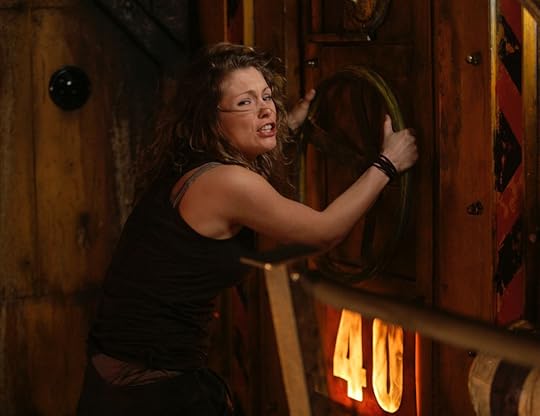
Forget favourite of Series 2: The Impossible Planet/ The Satan Pit is one of the best serials ever.
Everything about it is stunning: its themes, ideas, CGI, dialogue, design, direction, and music. Heck, even its lighting is superb. And it’s packed with spine-chilling moments, lines that could wake you in the middle of the night. Just like Midnight, we don’t know the threat. Not really. It’s the Beast. Is that the Beast? Is that a pretender? It doesn’t matter: he’s terrifying, even when confined. This is the tip of the iceberg. The things we don’t know – primarily about the ancient race that lived on Krop Tor – are incredibly enticing. Then there’s the Ood. Love an Ood.
The Pyramids of Mars villain Gabriel Woolf returns, giving a petrifying smoothness to every speech, one of my favourites being: “You know nothing. All of you: so small – the captain, so scared of command; the soldier, haunted by the eyes of his wife; the scientist, still running from Daddy; the little boy who lied; the virgin… and the lost girl, so far away from home. The valiant child, who will die in battle so very soon.”
And on top of all this majestic terror, we have one of my favourite lines accompanying one of my favourite deaths. I can forgive writer Matt Jones for killing off the lovely Scooti Manista (MyAnna Buring) because he does it brilliantly. Impossibly, Toby is standing on the surface of the planet, defiant and peaceful against the raging storms, revelling in his first taste of freedom in centuries. “He bathes in the black sun.” And Scooti reaches out to him, the temptation almost too much. She pulls away, but she can’t escape. The hull is breached. Chaos. Scooti’s missing, and the Doctor finds her, drifting towards singularity. Murray Gold’s score echoes the chilly abandonment, and David Tennant’s eyes are the very picture of sorrow.
I could write a 10,000-word dissertation on how good The Impossible Planet/ The Satan Pit is. But I don’t need to. Because if you’ve seen it, you already know.
James Whittington: The Girl in the Fireplace
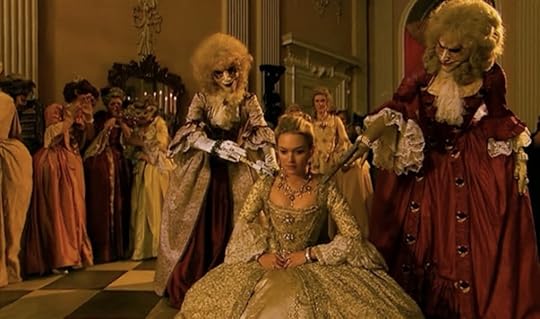
After the emotional pull of School Reunion, Series 2 (or whatever we called it back then) decided to try something a bit different to get our emotions running and introduced copious amounts of time travel to the core of the story.
Well, that’s what they appeared to do on the surface but scratch underneath and what we really have here is a delicate love story, one that is bigger than the series itself and tugged at everyone’s sentiments. Come on, admit it, when you knew the Doctor was falling in love with Madame de Pompadour you felt good and those final moments as he watched her coffin being driven away was just amazing television drama. The episode contains some of Steven Moffat’s most considered writing and gave David Tennant more to do than just play a slightly arrogant Time Lord with a self-satisfied demeanour.
Let’s not forget the Clockwork People, a great idea that helped pave the way for other robot foes to come along. Oh, and Billie who proved that she could do more than look doe-eyed at her Doctor; instead her green-eye of envy was perfectly played.
It’s a shame such a strong story was followed by the rather dull Rise Of The Cybermen adventure.
Those are a few of our favourites from Series 2. Now it’s your turn! Vote below for your favourite, and we’ll find out the overall winner later this year…
Take Our Poll
The post NuWho 10th Anniversary: What Is Your Favourite Series 2 Story? appeared first on Kasterborous Doctor Who News and Reviews.
051 – Spearhead From Space
Meredith Burdett is a writer at Kasterborous Doctor Who News and Reviews - All the latest Doctor Who news and reviews with our weekly podKast, features and interviews, and a long-running forum.
I know what you’re thinking as soon as you start to read this, ‘what can possibly be said about Spearhead from Space that hasn’t already been said before?’ In many ways, you’re right; this is the Doctor Who story that has had so much attention since its original airing in January 1970. It’s been released twice on VHS and DVD in England alone, then again on Blu-ray, and it formed part of the short lived Doctor Who reruns that started after Doctor Who Night in 1999.
It’s been dissected, discussed, praised, and critiqued by every Doctor Who fan and reviewer all over the world. It’s got so many firsts in Doctor Who history both in front and behind the camera that to list and discuss them all in this retrospective would take up most of the word count, but, one would imagine as you read this, you probably know all that anyway.
So what I wanted to talk about, in celebration of this amazing, wonderful, terrifying and unforgettable adventure, was the one thing that stuck with me from the very first time I watched it when I was a young lad; the fear… or rather, the fear of one man.
Stay with me on this one, I promise you that there’s good reason for this.
Doctor Who before Spearhead from Space, and in stories after it as well, always had to use fear in the correct context. This was a children’s show that quickly turned into a family adventure but never into an adults-only show. Over the top screaming and reaction shots aside, Doctor Who had always played it safe so that the kids watching could have a scare, possibly a bad dream or two but could always remember Doctor Who as an adventure rather than a never-ending nightmare. Of course, in the mid 1980s during the Colin Baker years the show came under heavy scrutiny for violence that was unacceptable but watching it now, you can see that that was partly due to inner BBC politics and not because the show was suddenly showing us graphic Saw-like deaths on Saturday teatime.
But what Robert Holmes and the production team on Doctor Who did with Spearhead from Space was something very clever indeed. They took a very, very simple and realistic scenario and turned it into something so horrible, so dark and so cruel that it stayed with me up until this very day. Maybe this essay is a way of ridding me of my Doctor Who demons but in many ways, I don’t want to ever forget that particular scene that scared me to death when I first watch Spearhead from Space on a lazy Saturday in the early 1990s.

Just to set the scene for you, I was told by my mother that, as my dad was out for the day, I would have to come with her to Twickenham High Street for a few hours whilst she did some shopping. If I was good, I could have a treat for the afternoon. Not sweets (I weighed a few more pounds then I should have when I was young) and not comics (I had too many). So I walked briskly and obediently along with my mother as she priced up odds and ends that she needed to get for the house to render it looking pleasant for future guests when they came around (this meant nothing to me whatsoever). I thought of what treat would best indulge my boring Saturday expedition to make all the walking worth it. And then I saw Blockbuster Video. This palace of wonders (that finally closed a few months back, sadly) held one of the largest resources of Doctor Who videos as I had discovered some weeks previously and so, after some quick negotiation (‘Mum can I rent 4 Doctor Who videos please?’ ‘No, you can rent 2.’ ‘Ok, fine’) I had The Curse of Fenric and Spearhead from Space on shiny VHS, clutched close to my chest and ready to watch when I got home. The rest of that shopping trip was a dream, I tell you, as I kept imagining in my head what each story would offer me.
Caroline John instantly has the Doctor intrigued; she’s clever, forthright, clearly doesn’t suffer fools gladly, and that just spurs the Doctor on. You can see as soon as he sets eyes on her, that this new incarnation of the Doctor is out to impress Miss Shaw.
Skip forward some few hours later and we get to the real meat of the story. I’m watching Spearhead from Space and I’m suitably terrified. The Autons have, after 30 minutes, taken their place for me as the scariest and most insidious Doctor Who monster ever (I didn’t know the word insidious at that age – I’m embellishing for you) and Channing’s cold and vaguely sweaty demeanour has me intrigued and unsettled. I’m also having an incredible amount of fun watching the whole adventure unfold as the Third Doctor starts his life with a big dose of trouble.
There’s so many other joys to this story as well: the Brigadier finally become a regular character that properly starts Nicholas Courtney’s incredible journey that left so many of us missing him since 2011. Caroline John instantly has the Doctor intrigued; she’s clever, forthright, clearly doesn’t suffer fools gladly, and that just spurs the Doctor on. You can see as soon as he sets eyes on her, that this new incarnation of the Doctor is out to impress Miss Shaw. The use of colour brings Doctor Who into a shiny new decade and the production team wastes no time in making use of the new format: the woods, the hospital, the horrible close-ups of Channing in full, bloody colour are all to be marvelled at.
But that’s not what sticks with me for so many decades; admittedly I still give a suspicious glare to shop window dummies, especially when I’m walking through Ealing High Street, but what really got to me was the build up and the death of poor old John Ransome played by the excellent Derek Smee.
You see, Ransome was an everyday chap like you or me. He worked hard, got paid and presumably had a nice little life outside of work, although sadly now, we’ll never know. But when he comes back from a business trip that has gone markedly well, he’s fired with no proper explanation. Finding himself at a loose end and understandably upset and confused, he heads over to his old workplace to confront his former boss, and it would seem from their conversation friend as well, George Hibbert. After having it out with his boss and having no success in terms of reemployment or explanations, poor old Ransome leaves a dejected man. His office has been changed, the work staff is new and he still is just as much in the dark as when he arrived.

So he decides to sneak back into the factory later and find out what’s going on. This proves the undoing of the man and leads to what I feel is one of the most terrifying and horrific scenes in Doctor Who. No, it’s not Ransome being chased by the Auton through the factory (although that terrified me as well) but the scenes afterwards, when he’s safely back with UNIT.
Fans from the UNIT of the Second Doctor era will remember that once the Doctor and his friends escaped the menaces they were facing and got back to UNIT HQ, they would have a short reprieve to relax. A bit of banter and a cup of tea before facing the menace again, usually. But in Spearhead from Space, Ransome has been through a life changing experience; he’s been running for his life through the woods, blind fear and panic causing his instincts to kick in and get as far away from his former place of employment as possible. Eventually, after what must have seemed an eternity, he’s found by UNIT troops and taken to a nearby encampment set up in the woods. Once there, he’s offered security, pleasant words and a cup of tea. All is better.
Except it’s not.
This is a new era for Doctor Who and anything can happen, and anything does. A cup of tea is offered to Ransome but the man is in too much shock to drink – the fear in his eyes, the shaking body, this is a broken man. He’s offered a sip of tea from a soldier, and the tea simply dribbles from his mouth, he can’t even drink it. The fear that’s clouding his very being has stopped him from taking a break from the alien menace of the week because for Ransome, there is no break, no stopping for a laugh and a giggle. He’s seen things that he never wanted to see, felt terror that he never thought he would feel and that tea, neatly dribbling from his mouth as he shakes and holds himself with his arms in some vague attempt to comfort his soul, chilled me to my very core. Gone were the free and easy days of alien menaces, Doctor Who had literally and metaphorically arrived on Earth with a loud bang and had caused the monsters to up their game in terms of how they were going to terrify human beings.

The fact that after that ordeal, Ransome is then hunted down and despite the fact that he’s in the safe and warm embrace of UNIT, is killed in the most horrible way possible, was a further ordeal to watch. He never found out why his life changed so dramatically, he never found out what it was that was chasing him and he never got to be saved by the Doctor. It’s one of the saddest and most terrifying character stories ever to have been shown in Doctor Who’s 50 year history.
Many years later, Russell T Davies would so something similar with his character Clive in 2005’s Rose: the man had all these ideas but before he could find out anything, he was shot by an Auton in a shopping centre in front of his wife and child. It’s a fitting testament to the longevity, terrific writing, acting, and direction that went into making Spearhead from Space so different and so brilliant to any Doctor Who story that that come before it or would follow afterwards.
Let’s hope that when the day comes (and let’s also hope that’s not for a while) and Peter Capaldi and Steven Moffat decide to move on from Doctor Who, that the production team and the new fella who plays the Doctor manage to get the changes as fantastic as Jon Pertwee, Derrick Sherwin, Derek Martinus, Robert Holmes and Terrance Dicks managed to.
Oh, and of course Derek Smee, the wonderful and talented actor that’s been scaring me for almost 30 years.
The post 051 – Spearhead From Space appeared first on Kasterborous Doctor Who News and Reviews.
Is This How Doomsday Should Have Ended?
James Lomond is a writer at Kasterborous Doctor Who News and Reviews - All the latest Doctor Who news and reviews with our weekly podKast, features and interviews, and a long-running forum.
Rejoice! The imaginative bods at How it Should Have Ended have provided us emotionally fragile masses with the ending we *thought* we wanted from the heart-wrenching finale of Series 2 on Bad Wolf Bay. After banishing both the Daleks and the Cybermen to the Void, Rose and the Doctor were separated by a brick wall and/or divided across dimensions. Cue the emo bass guitar (pure Gold as usual) and tears. In fact: cue sobbing, hysterical masses of fans the world over. It has even been used as a form of emotional torture amongst The Young…
This chucklesome vid gently pokes fun at how Russell T. Davies very deliberately tugged at fans’ heart-strings and how hindsight can cast a different light on a scenario. Featuring some preposterously English accents and various nods to the audience, this is a tonic for anyone still pining for the Tenth Doctor/ Rose romance. Be careful what you wish for…
Take a look at their other Sci-Fi and fantasy re-imagined endings here. We are promised there’ll be more Who installments…
The post Is This How Doomsday Should Have Ended? appeared first on Kasterborous Doctor Who News and Reviews.
Daylight Savings Timey-Wimey & Paternoster Doubts (PLUS: A Dozen Summers)
Christian Cawley is a writer at Kasterborous Doctor Who News and Reviews - All the latest Doctor Who news and reviews with our weekly podKast, features and interviews, and a long-running forum.
We have a packed podKast for you this week, dear listener, as Christian Cawley, James McLean and Brian Terranova attempt to get their heads around daylight savings time, the 12 (now 13) covers offered by Titan for their Ninth Doctor mini-series and Steven Moffat’s claims that the BBC would do a Paternoster Gang spin-off “in a heartbeat”.
The centrepiece of the podKast is probably Christian’s chat with Kenton Hall about his upcoming movie, A Dozen Summers, which features Sixth Doctor Who Colin Baker, and look out, as ever, for our recommendations…
Kasterborous PodKast Series 5 Episode 5 Shownotes
Titan’s Ninth Doctor comic series variant cover deluge
Steven Moffat confirms more two-parters
Paternoster Gang: is a spinoff really something the BBC wants?
A Dozen Summers
Recommendations: The Mind of Evil
 , Game of Thones Season 1 and 2
, Game of Thones Season 1 and 2 ,
Ripper Street
,
Ripper Street
 Series 1
Series 1Tim Treloar reads The Third Doctor Adventures
The Ark in Space read by Jon Culshaw
PodKast introduction by John Guilor. Theme tune by Russell Hugo
Listen to the PodKast
There are several ways to listen. In addition to the usual player above, we’re pleased to announce that you can also stream the podKast using Stitcher, an award-winning, free mobile app available for Android and iPhone/iPad. This pretty much means that you can listen to us anywhere without downloading – pretty neat, we think you’ll agree! (Note that it can take a few hours after a new podKast is published to “catch up”.)
Stitcher
Audioboom
What’s more, you can now listen and subscribe to the podKast via our Audioboom channel (formerly Audioboo)! Head to https://audioboom.com/channel/doctorwhopodkast and click play to start listening. You can also comment and record your own boos in response to our discussions! Meanwhile you can use the player below to listen through Audioboom:
You haven’t clicked play yet?! What are you waiting for? As well as our new Stitcher and Audioboo presence you can also use one of these amazingly convenient ways to download and enjoy this week’s podKast.
Use the player in the top right of the Kasterborous home page, or visit the podKast menu link.
Listen with the “pop out” player above, which also allows you to download the podKast to your computer.
You can also take advantage of the RSS feed to subscribe to the podKast for your media player, and even find us on iTunes, where your reviews will help the show considerably.
The post Daylight Savings Timey-Wimey & Paternoster Doubts (PLUS: A Dozen Summers) appeared first on Kasterborous Doctor Who News and Reviews.
Sorry, Rory Fans: Arthur Darvill is Engaged
Christian Cawley is a writer at Kasterborous Doctor Who News and Reviews - All the latest Doctor Who news and reviews with our weekly podKast, features and interviews, and a long-running forum.
It was a simple evening. Arthur Darvill and his girlfriend sat down to watch The Voice, when the former Doctor Who companion became baffled by the quality of the performances he saw.
So he took to Twitter, and left this message…
Me and my fiancée have found ourselves at home watching the voice on catch up. What an appalling talentless bunch of nonsense. Embarrassing.
— Arthur Darvill (@RattyBurvil) March 8, 2015
But rather than anyone spotting that the Rory Williams actor had tacitly announced his engagement to his girlfriend (whose identity remains closely guarded), he unwittingly caused a few angry replies and was forced to backtrack on his earlier dismissal of the show. Which is a shame, but hey, congratulations, Arthur.
The post Sorry, Rory Fans: Arthur Darvill is Engaged appeared first on Kasterborous Doctor Who News and Reviews.
March 11, 2015
DVD Revisited: The Reign of Terror
Simon Danes is a writer at Kasterborous Doctor Who News and Reviews - All the latest Doctor Who news and reviews with our weekly podKast, features and interviews, and a long-running forum.
There are no more classic series DVD releases, but the range continues to be available. In our new feature, we remind you of some releases that you might have overlooked, and give you reason to check them out at last. To start, Simon Danes takes a look at The Reign of Terror, episodes and extras.
Yes. OK. The Reign of Terror. Here we go.
Meh.
It’s not bad. It’s not terribly good, either. There are some good bits, and it picks up in the last couple of episodes, but it’s just rather dull.
I didn’t catch it when it was first broadcast: I was -1 at the time, so, like the rest of us, I had to wait until the DVD came out before I saw it (not having bought the VHS). As has so often been said, binge-watching Doctor Who DVDs isn’t the same viewing experience as waiting an entire week for the next instalment; the weeks wait meant that the original viewers wouldn’t have minded or noticed the fact that it’s all pretty slow.
That said, it’s still true that nothing much happens. The plot is little more than get captured – escape – get captured – escape – get captured – escape – and so on, until you’ve got six episodes’ worth. We’re in and out of the Conciergerie for a month and a half and it ain’t that interesting. There’s a comedy jailer in there, who isn’t very funny; a dumb attempt to dig through solid stone walls with a plank from a bed; nasty food; gormless looking extras, and some invisible rats. (Maybe they didn’t try pre-filming real rats at Ealing because they remembered the problems with the killer rats in the 1950s Rudolph Cartier / Peter Cushing 1984: the studio lights were so hot that the dear little chaps fell asleep and were about as menacing as comatose gerbils. Or maybe it was just to cut costs: film’s expensive, after all.)
The key image from the real reign of terror is the guillotine, and they never built one in the studio: you just have a bit of stock film clipped in from an old production of A Tale of Two Cities. I suspect lots of the original viewers would have wanted scenes set around the guillotine because they would have been tense, dramatic, scary – but maybe there aren’t any because they didn’t want to frighten the kiddies too much. Pity. We get a nice horse and a tumbrel, though. The sets are pretty good, too, particularly the exteriors of the Paris streets, though because this is 60s Who on a shoestring, said streets are eerily deserted. Except for a splendid Terry Jones-style old lady, who coughs and splutters her way across the screen. (‘Dennis! There’s some lovely filth down here!’)
The regulars, as always in the first season, are first class. Hartnell’s Doctor is still acid, spiky and unpleasant; he hasn’t yet become the kindly, giggling old twit of his later stories. A good man, but not a nice man: someone you’d have to know very well before you came to like him. His interaction with his companions is superb: the Tardis scenes are probably the best bits in the whole story, with Ian and Barbara – who clearly are very fond of him, despite his ordering them to leave the Ship and never come back – cajoling him into allowing them to part on good terms. There were moments which made me catch my breath: Hartnell’s passive-aggressive sneering at the tailor and the jailer, chin jutting forward as he sticks his face into theirs to wither them with a blast of sarcasm, is pure Peter Capaldi. Or the other way round, really; moments like that show how much Capaldi’s performance owes to Hartnell.
Would The Reign of Terror appeal to those who’ve been reared on NuWho? The more leisurely pace and the way it was shot would lead some to dismiss it. A pity, really, because the old continuous recording teachnique is in many ways superior to the single camera shooting of today. It allows the actors to dictate the pace, rather than the editor, and there’s a much more theatrical feel overall. (It’s an exaggeration, but there’s something to be said for the explanation of 60s TV as one-act theatre plays with cameras stuck in front of them.) These were, after all, the days when reps still existed; actors learnt their trade by playing a myriad of parts in rep, with a new show every week or two weeks; the prime medium for actors was theatre, not film or television. When you have an excellent cast, and it’s they who are dictating the pace and driving the scenes forward, the results are very good indeed (cf the Tardis sequences again). That’s something we’ve lost in modern TV drama, and it’s a shame.
But the problem is that The Reign of Terror has some pretty rotten acting (some of the aristos are very hammy, and the thuggish serjeant in part one has been reading The Art of Coarse Acting), and the script just isn’t very good. Nice to see Edward Brayshaw, though, well before he takes on the robe – or Nehru suit – of the War Chief, and Keith Anderson as Robespierre is convincing. The boy in the farmyard’s surprisingly good, too.
The Extras
Not enormously abundant. “Don’t Lose Your Head”, the ‘making of’ documentary, is great: the accounts of the problems caused by an under-experienced and over-stressed director are particularly interesting. Henric Hirsch’s dithering unsettled Hartnell, and Hartnell’s anxiety translated itself into belligerence; it’s not hard to imagine the shouting matches. Poor Hirsch had a nervous collapse, a very young Tim Coombe told Bill to back off, and it’s amazing that episode 3 ever got in the can. The production subtitles are as witty as always – it’s worth buying the DVDs just for them.
The animation? An enormous amount of hard work, love and dedication has obviously gone into them, and I don’t like to be negative, but I’m afraid I really didn’t like them. The characters’ movements are very clumsy, and the likenesses are often very poor. They’re not helped by over-heavy shadowing. Hartnell comes off worst; the Doctor looks like a talking skull. The backgrounds are nice, but… well, it didn’t work for me. While watching them, I wondered if it would have been better simply to have a rostrum camera over some line drawings of the characters in the scene; perhaps an artist could capture the sort of contemporary 60s’ look of Arnold Schwartzman’s or Henry Wood’s illustrations in the 60s’ Muller Doctor Who novels. Wouldn’t that fit the productions’ period better than computer animations? If the animations’ purpose is really to suggest the original episode, rather than to re-create it, I’d go for the rostrum camera and line drawings.
No? OK, maybe not. Just an idea.
The verdict: The Reign of Terror isn’t the nadir of Season One (The Keys of Marinus, anyone?), but it’s not its best, either: it’s miles away from the brilliance of An Unearthly Child or The Daleks. Not brilliant, not bad. Not hot, not cold. Not transcendent, not abysmal.
The Reign of Terror is available for just £6.50 from Amazon.
The post DVD Revisited: The Reign of Terror appeared first on Kasterborous Doctor Who News and Reviews.
Firing Loose Canons – Making the Cut
Alasdair Shaw is a writer at Kasterborous Doctor Who News and Reviews - All the latest Doctor Who news and reviews with our weekly podKast, features and interviews, and a long-running forum.
It never fails. Whenever I mention I’m working on a guide for alternate Doctors someone pipes up with a suggestion for entries. Sometimes, not often, it’s a useful suggestion. My Best Man, Andrew, pointing out that the Leader from Inferno was retconned into being an alternate Doctor by Paul Cornell in some of his books. Or Paul Hanley mentioning the existence of the Asian Doctor from the Chinese translations of the Target books. These were useful suggestions.
But more often than not it’s someone just not quite getting the concept. The most common misconception is that I’ll be including people that nearly got cast in the role or were considered at one point. I won’t, mostly because there’s no real meat to write about apart from snippets in newspapers and gossip magazines, but also because it would become a much larger project if I were to include everyone that’s ever been considered. Especially if you look at the suspect list for the TV Movie alone. I’ll make an exception for David Troughton, mainly because I’m intrigued by the preliminary work that went into a possible regeneration within the books. That and his heritage make him noteworthy.
I was sorely tempted but I can’t justify including the War Doctor as, of course, he’s an actual Doctor…
Sometimes, just sometimes, you have to put on a brave face and smile vacantly as people try and explain to you why Clara should get a chapter just because she pretended to be the Doctor and Steven Moffat messed with everyone by putting her eyes in the title sequence. But I can understand where those suggestions come from, even if I don’t agree with them. Then you get the occasional head scratching moments like when someone in the comments section for my opening column suggested that Romana should be in the book because of The Horns of Nimon.
Now I must confess to not having watched Horns, so I took to the Internet to find a quick summary of the episode and I’m afraid I’m none the wiser as to what they were getting at. The only thing I could find that made her Doctorish was that she acquired her own Sonic Screwdriver, but that’s really not enough to qualify for this particular guide.
Fan fiction is another suggestion that comes up on a regular basis. Now I have no issue with fan fiction at all, hell I’ve been guilty of it from time to time, but if I was to include every Doctor that had been created by a literary minded fan then I’d be forever more reading fan fictions of varying degrees of quality. There are, however, a few notable exceptions. The 42nd Doctor that crops up in Lance Parkin’s unprinted epilogue for The Dying Days springs to mind as does The Last Doctor from Paul Cornell’s short story of the same name. These gentlemen have written enough ‘proper’ Who that I’m inclined to read their unofficial stuff with a pinch of canon.
The Doctor from the Audio Visuals range is also, technically speaking, a fan creation. But those stories were brought to us by several fans that went on to become proper names within the Who world, that and Mr Briggs is blatently having a ball playing the Doctor.
A suggestion that I understand completely, but disagree with, is the War Doctor. He came out of left field and doesn’t have a number assigned to him. I was sorely tempted given his popularity just now, but I can’t justify him as he’s an actual Doctor. However Tom Baker’s appearance as the Curator in the same episode is worthy of inclusion for the same reason that the Valeyard is; he’s a possible future version of the Doctor. As is the Merlin mentioned in Battlefield and fleshed out (slightly) in the New Adventures.
Spoof versions are a bit trickier. I’ve always had a soft spot for Curse of Fatal Death and the fact it’s penned by Steven Moffat strengthens it’s inclusion so its Doctors are in. Mark Gatiss’ Doctor from Web of Caves gets a mention as he appeared on the BBC as part of Doctor Who night, that and Mr Gatiss knocks it out of the park. The Doctor that appeared as part of a sketch on The Lenny Henry Show also gets an honourable mention, partly as he appeared on the BBC and some Who DVDs, but mostly because I like him.
And I guess that’s what it ultimately comes down to; who I want to have in it.
Maybe that’s not the most scientific way of choosing, but until I have an editor hovering over my shoulder it’s the way it’s going to be…
The post Firing Loose Canons – Making the Cut appeared first on Kasterborous Doctor Who News and Reviews.
Dark Water Attracts Most Viewer Complaints Since 2005
Jonathan Appleton is a writer at Kasterborous Doctor Who News and Reviews - All the latest Doctor Who news and reviews with our weekly podKast, features and interviews, and a long-running forum.
Those who felt that the two-part finale of Series 8 sailed rather close to the wind won’t be surprised to learn that Dark Water attracted the highest number of complaints to Ofcom since the programme’s 2005 return.
There’s no data available on the specific issues people were unhappy about (beyond a rather vague reference to ‘generally accepted standards’) but it’s probably a safe bet that it was the references to dead people being able to feel pain during cremation that complainants felt were beyond the pale.
To place the figures in context, the total number of complaints received by the media regulator concerning the episode was… 19. Hardly an avalanche, then, especially when taken as a proportion of that programme’s 8.52million viewers that week, although it’s worth bearing in mind that over 100 people also complained directly to the BBC. And compared to the programmes that topped the Ofcom charts for complaints last year (Big Brother 3784, Celebrity Big Brother 1874, Cutting Edge 1805), Doctor Who’s figures do indeed look like pretty small beer.
But it be wrong to dismiss this story out of hand just because of the low numbers involved. Whether it was on Twitter, in discussion forums or printed reviews there was undoubtedly a level of disquiet following Dark Water that certainly hasn’t been typical of Doctor Who in recent years. The BBC was quick to defend the episode in the aftermath, pointing to the “heightened sci-fi world” of the programme, and stressing that the Doctor correctly dismissed 3W’s claims as a con.
It’s not hard, however, to imagine some younger viewers feeling troubled by hearing recordings of people begging not to be burned in their favourite Saturday night show. And given the decision earlier in the series, prompted by topical events in that case, to make a significant cut to Robot of Sherwood on taste and decency grounds, some people will surely be left wondering why Dark Water was felt to pass a threshold that the earlier episode did not.
Aside from the issues raised by Dark Water, there’s a rather entertaining rundown of the most complained about episodes of Doctor Who since 2005. Apparently Deep Breath attracted 11 complaints about scheduling, perhaps from parents who felt that a 7:50pm start time was too late for the nation’s youngsters…
What do you think? Was all that death stuff in Dark Water a bit much? Or is all of this a lot of fuss over not very much? Let us know!
The post Dark Water Attracts Most Viewer Complaints Since 2005 appeared first on Kasterborous Doctor Who News and Reviews.
March 10, 2015
The Audience Report That Dealt Doctor Who A Killing Blow
Philip Bates is a writer at Kasterborous Doctor Who News and Reviews - All the latest Doctor Who news and reviews with our weekly podKast, features and interviews, and a long-running forum.
A document that’s particularly hard to read has surfaced: the Audience Reaction Report for Season 24, which sounds as close to a death sentence as you’re ever likely to find. As we all know, Doctor Who hasn’t always been as popular as it is now, and was cancelled in 1989, and this three-page report shows just how unpopular it became in the mid- to late-1980s, with the BBC as well as the general public.
Season 24, I would argue, isn’t as bad as its reputation. Time and the Rani may have been a misstep, but Sylvester McCoy hits the ground running (yes, he’s not as mysterious and manipulative as later on, but he’s a great Doctor from the off); Paradise Towers was a great take on JG Ballard’s High-Rise (even if the writer Stephen Wyatt reckons he wasn’t influenced that much by the novel); Delta and the Bannerman showed a considerate, compassionate, and clever Doctor; and Dragonfire was a solid introduction for Sophie Aldred’s Ace – and gave us that glimpse at a darker Doctor – so much so that Steven Moffat would later comment how he was falling out of love with the show until that final speech drew him back in because, as he says, the story of a sad clown is the story of everyone.
But here, the Audience Reaction Report tears it apart, straight away noting that “the popularity of Doctor Who has continued to decline.” In fairness, it also states that its average audience of 4.9 million is pretty good considering it was opposite Coronation Street (whose average audience boasted about 15 million), but also that the AI has gone down to 60, 9 points lower than Colin Baker’s final season as the Sixth Doctor.
A further hit at Seventh Doctor fans (and there are a lot of us!) is the summary that says “neither the Doctor nor his assistant Mel [Bonnie Langford] were popular with the reporting viewers.” Only 28% of those questioned said the stories in Season 24 were good, and 30% said they liked “nothing” about the show. 58% still agreed that Doctor Who was a family programme.
The most gut-wrenching statistic, however, is that only 46% of those taking part wanted to see a new series of Doctor Who. They had already lost much of the audience when exceptional stories like The Curse of Fenric, Remembrance of the Daleks, and Ghost Light were broadcast.
Published in February 1988, this is a pretty damning report, especially for a TV show that was about to get really properly good again under the fresh air provided by Script Editor, Andrew Cartmel. And it’s not all bad: Sophie Aldred received a warm welcome, and when we interviewed Cartmel last year, he said:
“I was rooting for Sylvester and Sophie and I’m sure [John Nathan-Turner, producer] was aware of this. But ultimately it was his decision – and he made the right one. They were the only casting choices I was really invested in.”
It’s an interesting if damaging report from a time when Doctor Who wasn’t the BBC’s jewel in the crown. But then, Auntie Beeb are known to not appreciate their most popular shows to the extent they should.
The Report is online now, courtesy of the BBC Archive. Proceed with caution, and thank the stars Doctor Who remains as beloved as when it came back in 2005…
The post The Audience Report That Dealt Doctor Who A Killing Blow appeared first on Kasterborous Doctor Who News and Reviews.
Lovarzi’s Doctor Who Umbrellas – Reviewed!
Philip Bates is a writer at Kasterborous Doctor Who News and Reviews - All the latest Doctor Who news and reviews with our weekly podKast, features and interviews, and a long-running forum.
This seems an unexpected move, but Lovarzi are known to find that gap in the market. That’s why they’ve previously given us the best-selling Fourth Doctor Scarf, the Burgundy Season 18 Scarf, and the Fifth Doctor Sweater. And that’s why we’ve now got two beautifully-designed umbrellas.
Let’s start with the folding umbrella. When initially announced, I thought this would be the more widely-bought item of the two, seeing as it’s concise and comes in a specially-made carry case. It’ll fit into a handbag or can just be carried around conveniently. There’s a bit of weight there, but nothing to drag you down too much. Most high-street umbrellas are of this design, though not, I would say, of this quality.
And while I’m certain this one will sell well, it is the lesser of the two umbrellas.
The handle feels solid enough and looks the part… It’s very hard not to keep stroking it in a slightly odd way.
As I say, the quality of both is excellent, but the artwork on the folding umbrella niggles this reviewer somewhat. It is standard in-house artwork fashioned by the BBC: the TARDIS on an alien world, topped off by some Gallifreyan across a 21″ canopy. The pattern is crisp and striking. That alien world might even be the Doctor’s home planet – the wastelands or the Death Zone – but the BBC also has odd design quirks that will irk some fans.
Most notably, inside the Gallifreyan is “Time Lord”, or more specifically, “TME LRD.” I’ve no idea why they’ve left out two vowels, but it’s likely because the designer thought it looked cool. Now, this doesn’t particularly bother me, but I know fandom, and fandom is a funny old beast. This will put some off this particular umbrella. Another potentially-irritating factor is the TARDIS, which appears to be the one piloted by the Ninth and Tenth Doctors yet also comes with the St. John’s Ambulance sign that adorns the Eleventh and Twelfth Doctor’s Time-Space Ship.
That sections of fandom will be put off this umbrella due to design inconsistencies is a huge shame, because the umbrella in itself is a great thing.
As mentioned before, it’s compact, noticeable, and comes in a carry-case. Made with an aluminium shaft and durable fibre glass frame, there’s a pleasing weight there; strong enough to resist the wind, but light enough not to make your arm ache. The handle feels solid enough and looks the part, and the automatic open and close is a handy, cool feature.
I’ve no idea why they’ve left out two vowels, but it’s likely because the designer thought it looked cool…
I’m probably being a little harsh: I have no qualms with the artwork personally (I find it intriguing, sharp, and a gorgeously rich colour), but I know some will. And those people should instead turn to the TARDIS Stick Umbrella, which is a triumph.
Exclusively designed by Lovarzi, you won’t find this textured TARDIS front pattern anywhere else. It’s that deep, comforting blue that looks oh-so-inviting in any weather – but there’s an added layer here. It’s dotted with graffiti-esque patterns, like ink or oil on water; carefully-placed splodges akin to the odd shapes that momentarily crawl across your eye when opening them to sudden bright sunlight. The TARDIS itself looks like wood, almost palpably so, but it’s edged by streaks of watercolour, like rain caressing a window.
It’s moody, atmospheric, and textured. It’s very Doctor Who.
This design covers a 23″ canopy, and is supported by durable fibre glass. Perhaps because it’s spread across a greater distance, this Stick Umbrella is surprisingly light too.
And then there’s the rubber-coated handle, the perfectly smooth grip that tops off an ideal product. It’s very hard not to keep stroking it in a slightly odd way. Let’s never mention that again.
There’s little else to say about this lovingly-crafted item. It’s certainly better quality than you’d find merely in a high street store. I love it, and I’m sure you will too. As far as I’m aware, these are the only officially-licensed Doctor Who umbrellas in the UK (that Seventh Doctor one is, I believe, a US import), and are a welcome treat for any Whovian.
In summary, then, these are two excellent items; a great if unexpected extension to Lovarzi’s already-wealthy Doctor Who range. And considering the company has now started to make Sherlock stuff, let’s hope some 221B-related umbrellas are on their way.
The ‘Time Lord’ Folding Umbrella and TARDIS Stick Umbrella are both out now, priced £34.99 each, and are available from the Lovarzi website, BBCShop, Forbidden Planet, and Amazon UK .
.
The post Lovarzi’s Doctor Who Umbrellas – Reviewed! appeared first on Kasterborous Doctor Who News and Reviews.
Christian Cawley's Blog
- Christian Cawley's profile
- 4 followers



